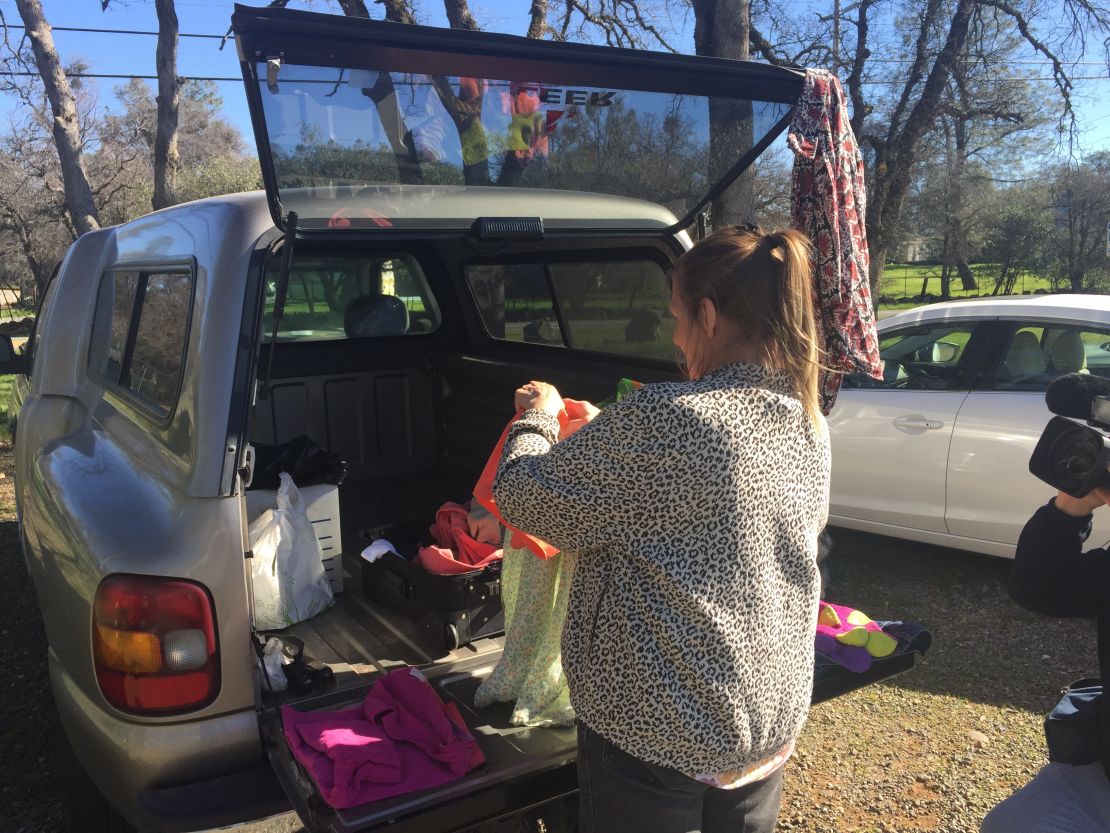Story highlights
Residents are being allowed to return to their homes
President approves emergency funds
With the water level at California’s Lake Oroville dropping, authorities lifted a mandatory evacuation order, allowing tens of thousands of residents to return to homes near the reservoir’s dam.
But Butte County Sheriff Kory Honea on Tuesday cautioned residents and business owners to “maintain situational awareness” with a series of storms forecast for later in the week.

“People who have special needs or require extended time to evacuate should consider remaining evacuated,” the sheriff said.
Heavy rains last week caused the lake level to rise until the water began to pour down the emergency spillway on Sunday. Authorities ordered people to leave the area when a hole developed in an eroded area of the spillway, affecting about 188,000 residents. Officials worried the spillway would fail, and one warned a “30-foot wall of water” could flood the communities below the dam.
Fears of such a disaster have largely been alleviated. Lake Oroville was down to a level of 887 feet on Tuesday, still 37 feet above where officials want it to be ahead of the forecast rain.
Dump trucks and cement mixers shuttled in material as workers rushed to fortify the damaged emergency spillway, which allows excess water to run out when the lake level rises above 901 feet. They dropped huge white bags filled with rocks into the hole that had opened up in the spillway, and deposited large chunks of concrete to protect it from future erosion.
With the work being done to increase outflow, Bill Croyle, the state’s acting director of water resources, didn’t expect that the emergency spillway will be needed, particularly since less rainfall is expected this week than in previous storms. The spillway should be repaired within 24 hours, he said.
“We have addressed the issue … but will continue to increase our mitigation measures to increase its ability to handle a high-water event,” Croyle told reporters.
Help from the air
Helicopters have been dropping bags of rocks into the gouged portion in an effort to plug the hole.
“Our crews are working around the clock, 24/7, to try to get as much rock as possible onto the damaged spillway before the next storms come,” Cal Fire spokesman Josh Janssen said.
“We are feeling positive,” said Al Duncan, spokesman for the response team.
Janssen said the lake level has been dropping about a foot every three hours – and that rate could improve.
“Lakes are shaped like funnels, so we could see the water level start to drop faster,” he said.
More rain expected
The next wave of rainfall will come overnight Wednesday into Thursday, CNN senior meteorologist Dave Hennen said. A series of storms will follow and last through the weekend.
Rainfall over the next week could total 5 to 12 inches and will likely push hundreds of billions of gallons of water back into Lake Oroville, Hennen said.
The National Weather Service forecast for the next seven days includes a chance of rain each day.
Request for federal aid
Gov. Jerry Brown said he had requested federal response aid. President Donald Trump on Tuesday approved federal funding through the the Federal Emergency Management Agency and declared an emergency in the state.
“FEMA is authorized to identify, mobilize, and provide, at its discretion, equipment and resources necessary to alleviate the effects of the emergency,” the White House said.
White House press secretary Sean Spicer earlier cited the situation with the dam as “a textbook example of why we need to pursue a major infrastructure package in Congress. Dams, bridges, roads and all ports around the country have fallen into disrepair.”
Tallest dam in the US
The Oroville Dam, the tallest dam in the United States, provides flood control for the region. The dam itself has no structural issues, but the two spillways that release water from the lake to prevent overflow have structural problems.
The main spillway, which is lined, or paved, has a hole almost the size of a football field and at least 40 feet deep
It’s being used to drain the lake at a rate of 100,000 cubic feet per second in an effort to reduce the water level. Normal flows down the main spillway are about 55,000 cubic feet per second.
The emergency spillway, which is an embankment covered with trees, is a last resort and was used for the first time in its 48-year history on Saturday. Lake water began washing into it this weekend and prompted the evacuation order when officials noticed damage.
How did we get here?
Questions remain over how it got to this point at Lake Oroville. Why weren’t more efforts made to prevent spillway erosion after concerns were raised more than 10 years ago?
Croyle said he was “not familiar with 2005 documentation or conversation” about spillway concerns and emphasized the efforts underway to understand the current dynamics of the dam.
Damage to Oroville Dam spillway sparks flood fears
“We’re going to continue to work on the challenges we have,” he said.
The governor defended the state’s flood infrastructure Monday and said he welcomed “more scrutiny” as efforts continue.
Evacuee: ‘They’ve all been good to us’
Oroville resident Cheri Rorick said Tuesday she has always thought the Oroville Dam is one of the prettiest spots in the county.
“I don’t think you even think about it. It’s beautiful, you want to go look at it,” she said while folding clothes in the back of her pickup.
Rorick, who had been forced from her home and into a shelter just off a rural two-lane stretch of Oroville Bangor Highway, thinks that now “maybe it’s not so pretty.”

She said when she first heard about the dam’s problems, she didn’t believe it. Then her landlord told her to evacuate. She hastily gathered her things.
“It didn’t sink in right away, but when it did you just kind of piled everything together and did what you could. I couldn’t fit everything in my suitcase, so I just kind of brought it like that,” Rorick said, pointing at the suitcase she was trying to organize on the bed of her pickup.
Rorick was staying at the shelter with her mother and her aunt and uncle, who are visiting from Ohio.
“They’ve all been good to us here,” Rorick said.
Paul Vercammen and reported from Oroville and Holly Yan and Steve Almasy reported and wrote from Atlanta. CNN’s Bill Kirkos, Emanuella Grinberg, Eliott C. McLaughlin, Madison Park, Carma Hassan and Kayla Rodgers contributed to this report.
















